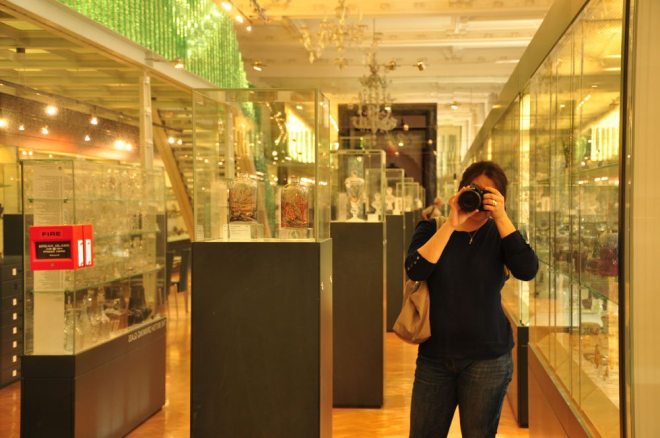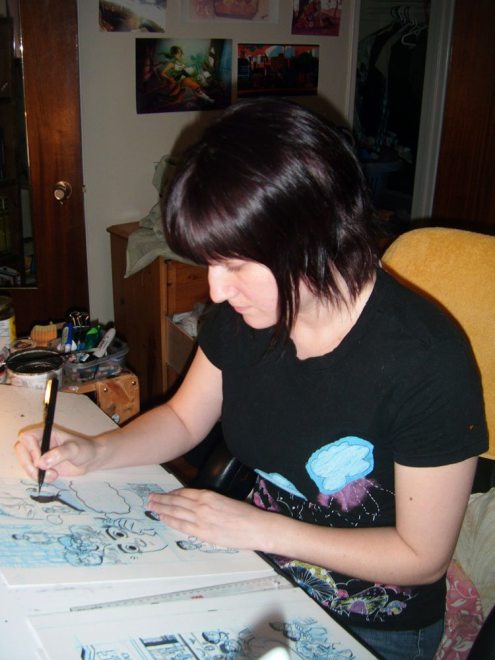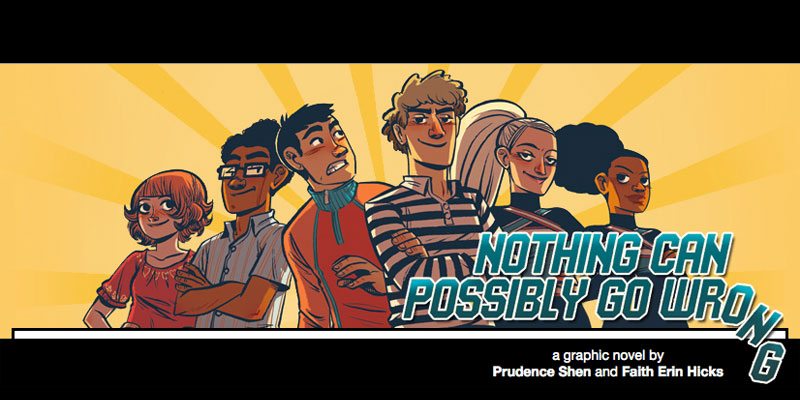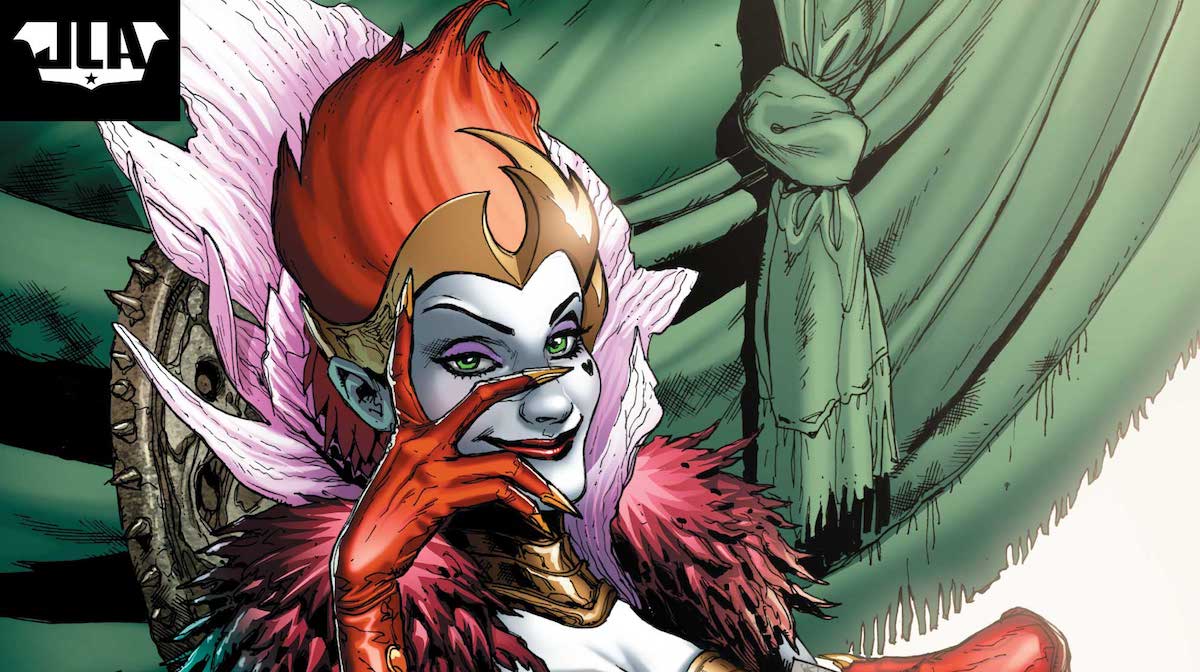 The robotics club needs money to go to a national competition. The cheerleaders need money for new uniforms. And the decision will be up to the student council. This leads Nate, president of the robotics club, to run for student body president—against his sort-of friend Charlie, captain of the basketball team.
The robotics club needs money to go to a national competition. The cheerleaders need money for new uniforms. And the decision will be up to the student council. This leads Nate, president of the robotics club, to run for student body president—against his sort-of friend Charlie, captain of the basketball team.
Nothing Can Possibly Go Wrong is a graphic novel by Prudence Shen and Faith Erin Hicks about bad sportsmanship, robots with chainsaws, scary cheerleaders, and bad politics. As with Hicks’ last book, Friends With Boys, NCPGW is being serialized online—it’s nearly complete but you can start at the beginning and read through it. Or, if you like having a hard copy, the physical version goes on sale May 7. There’s even a pre-order prize giveaway currently running (with special prizes available for teachers and librarians!) so if you’re already planning to pick it up, be sure to put your name in the drawing.
I got an early look at the finished book, so here’s a brief review as well as a Q&A with Shen and Hicks.As Hicks and Shen explain on page 1 of the online comic, NCPGW was originally a novel, but I think it works really well as a comic book. The book has a good mix of dialogue and action scenes. While it’s not all funny, it’s more of a comedy than drama, and the bad decisions made by everyone (mostly Nate and Charlie) lead to hilarious consequences. Nate is arrogant and often totally bone-headed; Charlie seems like a nice guy but is a complete pushover when it comes to the cheerleaders. And Joanna, one of the members of the robotics team, is adorable and bloodthirsty. Hicks does a great job of portraying the characters and is able to communicate a lot with facial expressions.
My favorite part of the book is just all of the scheming that happens surrounding the election. I won’t spoil it for you, but Nate and the cheerleaders are totally shameless in trying to get votes—and in a contest of this sort, nobody really wins. Except, of course, the spectators.
Here’s a brief Q&A with Shen and Hicks.
GeekDad: Hello, Prudence and Faith! I’ve gotten to read Nothing Can Possibly Go Wrong and really enjoyed it. Prudence, what were your inspirations for the book: how much experience do you have with robots, for instance? And do you know these people in real life?

Shen: Hi back! I—personally—am completely hopeless with all things that require even the smallest drop of engineering savvy (there’s a lamp in my living room this proves this conclusively), but I have always loved putting together intricate projects. For as long as I can remember though, I’ve been really fascinated by robots. This is cliche, but the first one I loved was R2D2, and I’m hugely charmed by how people interact with robots, and how with almost no provocation we humanize them. Certainly we build them as tools, but I was at Robogames just last week, and little kids of all ages were waving “hello” like they were making new friends. And cheering for robot carnage in the battle rounds. To be honest, watching robot carnage is mostly my experience with robots, but I am an expert at having survived adolescence.
I know people who share characteristics with the Nothing Can Possibly Go Wrong characters in real life, but they’re by no means based on anyone intentionally. Although I will openly admit that all the worst personality traits are borrowed from me.
GeekDad: How much did the two of you work together for the adaptation? For instance, did the original novel have visual descriptions of all the characters, or did Faith just make up what they looked like? What about The Beast?
Shen: The original novel did have visual descriptions for the characters, but they weren’t exhaustive. I think Faith really caught the essence of their personalities, which was the most important part for me. The Beast is actually an interesting one! I had drawn a picture of my mental image of The Beast just to keep it consistent as I was writing, and I took a very poorly lit cameraphone photo of it for Faith fairly early in the drawing process. The Beast in the final version of the graphic novel does bear a definite resemblance.

Hicks: We didn’t work together too closely when I was adapting the original prose novel, although later in the process, once I’d written the script and was drawing the pages, we collaborated on a couple of scenes. None of the characters in Nothing Can Possibly Go Wrong were explicitly described in Pru’s novel; I think the only reference to their appearance was Nate having “dirty blond hair” and Joanna having “red hair,” so I pretty much designed them from scratch. I had a lot of fun doing that. My favourite designs were the cheerleaders. I loved drawing their outfits.
As for the robots, especially the Beast, they caused me great pain. Robots are really hard to design properly! There was some reference to how the Beast looked in the original novel, but it was difficult to translate that into an appealing visual design. I did a lot of looking at various fighting robots from the show Battle Bots for the final Beast design.
GeekDad: The geeks vs. cheerleaders theme reminded me a little of Glee, although there it often feels that the real contest is between faculty members and the students are more like pawns. Here, the adults seem largely absent with most of the action (and bad decisions) left up to the kids. Was this your impression or experience in high school?
Shen: For me, at least, adults were present, but not obtrusively. My parents framed my home life and my classes were demarcated by various teachers, but they weren’t involved in any of my passions. That might just be because writing is a fundamentally solitary activity or careful cropping of memories, but most of memories of being a teenager involve hanging around with my friends or sneaking onto the computer at 3 a.m. to work on awful stream of consciousness second person short stories.
Hicks: In the original novel, Nate had a family who was at least slightly concerned for his welfare. I had to cut them out of the comic due to time constraints. But for the most part the adults in the story seemed a bit oblivious, although they do attempt to understand why Nate and Charlie are acting the way they are. I have some sympathy for Charlie’s parents; they have good intentions and they love their kid, but they’re failing utterly to listen to him and his needs. I was really really shy and quiet in high school and had a hard time communicating with my peers; teachers were the few people who noticed me, probably because I worked pretty hard on school assignments and liked writing. I actually had a teacher in high school sit me down and tell me I was a good writer and that I should consider pursuing it, which was really nice of him. I dedicated my first published book to him.
GeekDad: What’s the most fun to write/draw, the conversations between characters or action scenes (like the robot rumble)?
Shen: The robot rumble action sequences were a NIGHTMARE to write — and I think Faith will agree that they were a pain in the rear end to draw, too, if some of the emails from that period of time are any sort of indication. Action sequences are always horrible to put together, because you have to keep the plot moving, the characters moving (literally), and not confuse the thing or bog it down. Skimming over it in this case was not an option.
My favorite pieces to write are always the comedy bits. Any scene where Nate and Charlie are having contretemps in a hallway (and there were actually more of them in the original prose novel, I think), I’m having the time of my life. I love writing dialogue and squabbles and the narrative equivalent of the lopped-off comedy shot in films.
Hicks: Well, the robot fight scenes were certainly harder, which is sometimes fun? I think I experienced a bit of a breakdown drawing the robot fight scenes, they’re just so intense! And robots are really hard to draw! I guess they’re “fun” now that I’ve actually finished drawing them. The scenes I liked best to draw were scenes with the cheerleaders (I love them) and scenes where there’s over the top comedy, like Nate and Charlie threatening each other and all the crazy reactions. I love drawing that stuff.
GeekDad: Do you have any favorite pages or scenes?
Shen: Football field + weed killer = JOY. Hands down.
Hicks: I really liked drawing the scene where the Science Club goes to Holly’s house to beg for money to soup up the Beast, and she and Nate get into a shouting match. It was just fun to draw them stop pretending to be civilized and go at each other, but then to stop, take a step back and try and work together. I kind of ship Nate and Holly. It’s the Cordelia/Xander thing.
GeekDad: Thanks for your time! Good luck with the book release!
Shen & Hicks: Thanks!
Photos provided by First Second Books.




